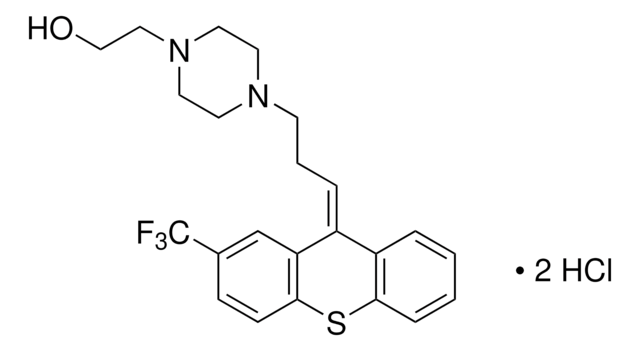5.05723
SCH 23390 Hydrochloride
Synonym(s):
SCH 23390 Hydrochloride, Dopamine Receptor D1/D5 Antagonist, SCH 23390, (R)-(+)-7-Chloro-8-hydroxy-3-methyl-1-phenyl-2,3,4,5-tetrahydro-1H-3-benzazepine Hydrochloride, SCH23390, SCH-23390
About This Item
Recommended Products
Assay
≥99% (HPLC)
Quality Level
form
solid
potency
0.2 nM Ki
manufacturer/tradename
Calbiochem®
storage condition
OK to freeze
protect from light
color
off-white
solubility
water: 100 mM
storage temp.
−20°C
InChI
1S/C17H18ClNO.ClH/c1-19-8-7-13-9-16(18)17(20)10-14(13)15(11-19)12-5-3-2-4-6-12;/h2-6,9-10,15,20H,7-8,11H2,1H3;1H/t15-;/m1./s1
InChI key
OYCAEWMSOPMASE-XFULWGLBSA-N
General description
Biochem/physiol Actions
D1 and D5
Warning
Reconstitution
Other Notes
Pfeiffer, R. F. 2002. Drugs Aging.19, 561.
Legal Information
Storage Class Code
11 - Combustible Solids
WGK
WGK 3
Flash Point(F)
Not applicable
Flash Point(C)
Not applicable
Regulatory Information
Certificates of Analysis (COA)
Search for Certificates of Analysis (COA) by entering the products Lot/Batch Number. Lot and Batch Numbers can be found on a product’s label following the words ‘Lot’ or ‘Batch’.
Already Own This Product?
Find documentation for the products that you have recently purchased in the Document Library.
Our team of scientists has experience in all areas of research including Life Science, Material Science, Chemical Synthesis, Chromatography, Analytical and many others.
Contact Technical Service








